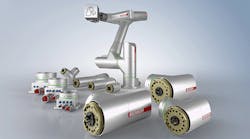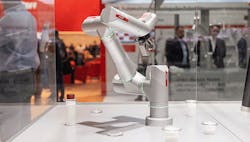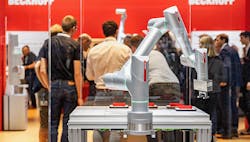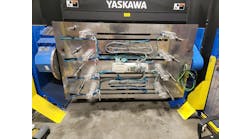Matt Prellwitz is drive technology product manager at Beckhoff Automation.
Tell us about your company’s state-of-the-art robotics technology.
Matt Prellwitz, drive technology product manager, Beckhoff Automation: Beckhoff recently announced ATRO, the automation technology for robotics system. ATRO is a truly modular, customizable concept for robotics applications, which allows users to select the exact number of axes needed for the application, including up to 16 robotic arms (Figure 1). The solution’s flexible robot kinematics fit essentially any application with payloads up to 10 kg and reach of up to 1.3 meters. Beyond that, its innovative approach to routing media feeds for communication, power and fluids internally enables endless rotation of the modules, so the robot never needs to stop to unwind, for example, a compressed vacuum line or Ethernet cable (Figure 2).
Also read: Autonomous mobile robots’ value is more than just speed
Figure 2: ATRO routes power, communication and fluids internally in an innovative design that enables endless rotation. (Source: Beckhoff)
Programming takes place in the standard TwinCAT engineering environment, resulting in seamless synchronization with advanced mechatronics, like XTS and XPlanar, as well as other motion systems (Figure 3). With simple robot assembly, intuitive teaching and TwinSAFE Motion functionality onboard, ATRO delivers a new approach to industrial robotics. This do-it-yourself (DIY) approach gives engineers greater control while gaining even more capabilities.
What have been the biggest improvements to robotics technology in the past five years?
Matt Prellwitz, drive technology product manager, Beckhoff Automation: Robotic systems are increasingly offering new ways to adapt to application requirements. Emphasizing modularity and customizability in this way benefits machine builders, integrators and equipment end users alike. Robots can take up less space, use only the number of axes required and offer easy motion teaching. The amount of flexibility now, particularly with ATRO, is incredible. You don’t have to make your application fit the robot; you can make the robot fit your application.
What’s the most innovative or efficient robotics technology application you’ve ever seen or been involved with?
Matt Prellwitz, drive technology product manager, Beckhoff Automation: I’ve seen many impressive robot applications over the years, though, including the Pickfeeder unscrambling machine from Spanish machine builder Packfeeder. The machine identifies bottles with GigE cameras, then uses pick-and-place Delta robots to set them onto XTS movers, creating a synchronous outfeed. By using a fully integrated control platform with EtherCAT, well known as an ideal motion bus, machine builders can implement many innovative robotics applications.
Figure 3: As demonstrated at Automatica 2022, ATRO offers seamless integration with advanced motion and mechatronics solutions, including XPlanar. (Source: Beckhoff)
While I was a Beckhoff application engineer, I also worked on a project for a large window manufacturer, where a robot milled window frames. The job used to take two robots, one on either side to cover each separate work plane. But the manufacturer was able to implement one robot, working at faster speeds, that could switch work planes—reverse its normal points of reference on the fly. This solution sped up production by 50% and reduced robot costs by 50%.
How has robotics technology benefitted from remote monitoring and connectivity?
Matt Prellwitz, drive technology product manager, Beckhoff Automation: Robots have benefitted immensely from these technologies. We find that the main barrier to successful robot implementation is connectivity: Can the machine controller easily, securely communicate to higher-level systems? With a fully integrated, PC-based control platform, that’s not an issue. And by leveraging an end-to-end engineering and runtime platform, it’s easier to design, monitor and make changes to a robot application. The same software provides PLC, IoT and robot kinematics, as well as all other advanced machine functionality.
Can you explain how software development has changed robotics technology design and production?
Matt Prellwitz, drive technology product manager, Beckhoff Automation: Openness and flexibility have become more important. Machine builders and systems integrators keep accomplishing impressive robotics applications that were once unimaginable. These are complex systems, and engineers want to be able to program disparate technologies—PLC, mechatronics, machine vision, functional safety, machine learning—in the same environment as the robot kinematics. While some in the industry may still be surprised that you can handle this amount of functionality on one machine controller, it’s been done successfully in the field for years. Not only does this save time, but also it ensures the systems will work well together. Beckhoff works with the world’s top robot manufacturers to make this a reality. For example, Denso has adapted this philosophy for its RC9 system, which uses an IPC, EtherCAT I/O and TwinCAT as the standard robot controller.
On the control side of ATRO, standard automation software simply scans the adapted structures, and the TwinCAT robotics functions automatically create the corresponding control application, as well as a digital twin. Also, a range of TwinSAFE Motion capabilities are available for the industrial robot, such as SLS, SOS, SS2, STO and others. Full integration into the Beckhoff control platform, along with EtherCAT communication, enables seamless, synchronized coordination with all types of motion systems found in machines, from conveyors and servos to XPlanar and XTS.
How do robotics technologies figure into digital-twin platform models being used by manufacturers?
Matt Prellwitz, drive technology product manager, Beckhoff Automation: Digital-twin technologies are certainly accelerating success for a number of our customers. Robotics is no exception. As we prepare for the full ATRO product launch, we are continuing to add functionality, including in this area. Already the TwinCAT robotics functions generate a digital twin automatically after scanning the adapted structure and creating the control application.
During programming, you can also pull in the CAD file of the machine or fixture where the ATRO unit will be installed and simulate motion profiles. You can then build an orbit around sensitive equipment, such as expensive sensors or other robots, to ensure the system will not enter that area or cause any damage. We also have incorporated the same web-based live-view technology that’s built into our XTS and XPlanar technologies. So you can connect to the ATRO system to analyze what the robot is doing, how well its performing and what the EtherCAT diagnostics show to assess potential optimizations.
When will robotics technology become IT-friendly enough that engineers are no longer required for installation and operation?
Matt Prellwitz, drive technology product manager, Beckhoff Automation: Robot manufacturers and others have been working on this for years. In the past, robots were always fixed in the same spot in a plant and repeated the same motion for their life cycles. In the era of Industry 4.0, however, greater flexibility for customization is needed to meet changing market demands. We designed ATRO to be easy to assemble, teach and reconfigure to meet the requirements of today and the future.
Using a Hirth joint and one adjustable tool, practically anyone can assemble an ATRO system in a very short time. Beckhoff first demonstrated the easy manual removal and reconfiguration of ATRO joints, along with the intuitive movement teaching mode, at the Automatica 2022 trade show in Munich where we announced this exciting technology. Beckhoff will continue to show its easy setup at trade shows and events.
What future innovations will impact the use of robotics technology in discrete-manufacturing operations?
Matt Prellwitz, drive technology product manager, Beckhoff Automation: There is a staggering number of robots now in use. But many are inflexible, take up valuable floor space due to the necessary safety barriers, and, all too often, they’re inefficient. As such, I expect to see further modularity, ease of assembly and intuitive teaching in robotics. Cobots will also be on the rise as a way to assist workers while maintaining the necessary safeguards. And, really, I believe engineers will start reducing the number of robots in their applications by embedding new mechatronics technologies into machines.
Many intelligent mechatronic systems, like the XTS and our XPlanar flying motion system, offer the capabilities to transport products, as well as use their movers in place of motion/CNC axes for processing. It’s not about eliminating robots but leveraging them more intelligently in process steps where they truly excel.









